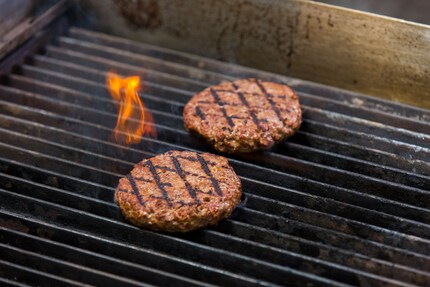Here's the deal. It looks like meat, it's meant to have a similar texture to meat and the 2.0 version apparently tastes even more realistic. According to the company, the patties are a sustainable product: a lot less water is needed to make them, they're responsible for fewer pollutants and you don't need as much land as you do for cow meat. All the ingredients that go into the «Impossible» burger are de facto vegan and plant-based (more on that later).
It's crazy how much this mock meat looks like the real thing. To be honest, I've never really understood why there's a market for vegetarian or vegan meat substitutes. I mean if you've given up animal products, it should automatically mean you don't eat pretend sausages made of mushrooms and wrapped up in artificial casing. These sausages don't have a meat odour. They don't taste of meat or have the same consistency. I can't get my head around tofu as a meat substitute either. Tofu is a distinct product that you certainly can't compare with meat. But perhaps you're someone who has given up meat for ethical reasons. You might like the taste but you don't want to have killing animals for food on your conscience or perhaps you want to minimise your carbon footprint. In which case, the Impossible Burger should be right up your street. It's the first meat substitute you could legitimately describe as such.
Having said that, «Impossible» aren't the first company to have devised a 1:1 plant-based meat substitute. But what is for sure is they're the most consistent. The brains behind «Impossible» have worked out what it is that makes meat taste and seem like meat. It all comes down to a molecule in the blood called heme, which transports oxygen. It's also what makes meat look red. Quite by chance, this iron-rich molecule can also be found in the root of the soya bean plant. But there were still problems isolating this molecule. It would have been too complicated and drawn out a process. That's why researchers used GM technology to grow yeast via a fermentation process similar to that of brewing beer or making wine. The heme produced is mixed with protein from wheat and potatoes. Coconut oil adds the fat content that melts when it’s fried and makes the burger juicy.
Until recently, you could only get your hands on the Impossible Burger in the US, Hong Kong and Macau and even then only in restaurants. I couldn't work out if they'd conquered Europe yet. The company hadn't replied to my request for a comment. But get back to me they did. And according to their statement, right now they're concentrating on the Asian market. The next stage of their plan is to start selling in Singapore. In Europe they've applied for the necessary licences. But at the moment the company can't predict when the burgers will be available in this part of the world. The success of the company so far gives me some hope it won't be in the too distant future. After all, Google, UBS and Bill Gates are among their star-studded list of investors. And the fake meat has already taken the US by storm, where it's available in 5,000 restaurants. The plant-based burgers could potentially be sold in Switzerland despite the genetically modified yeast on their ingredients list. Certain companies are allowed to sell GM products in this country if they have the right licence. But that wouldn't stop some people being put off by the genetic engineering involved. What's more, the patties aren't exactly vegan. To get the approval of US authorities, the burger had to be fed to rats in animal testing experiments. This led to conflict in the vegan community. Does that make the Impossible Burger not vegan because the well-being of animals has to come first? Or should we just turn a blind eye to the one-off animal testing?



